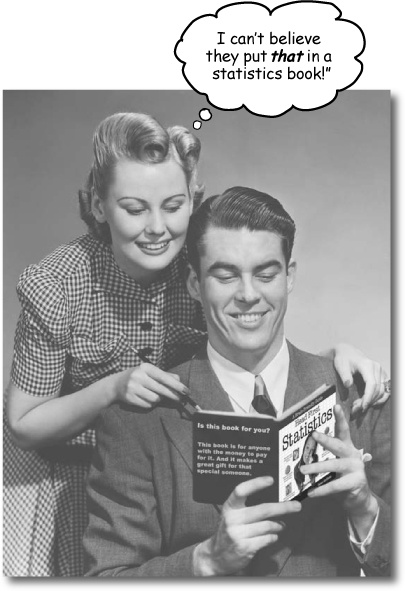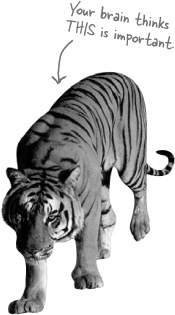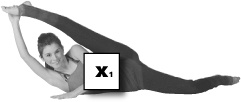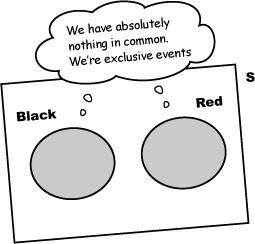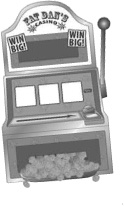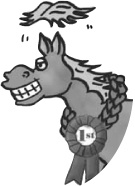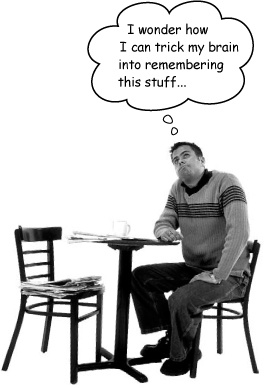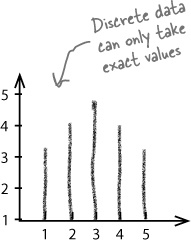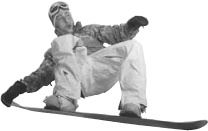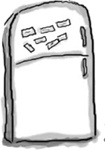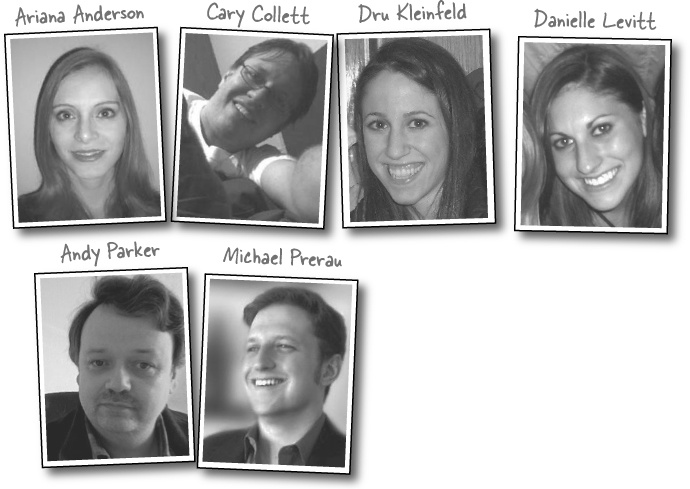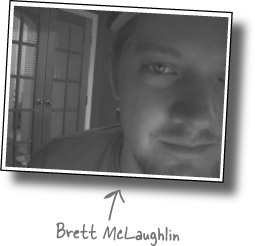How to use this Book: Intro
Who is this book for?
If you can answer “yes” to all of these:
Do you need to understand statistics for a course, for your line of work, or just because you think it’s about time you learned what standard deviation means or how to find the probability of winning at roulette?
Do you want to learn, understand, and remember how to use probability and statistics to get the right results, every time?
Do you prefer stimulating dinner party conversation to dry, dull, academic lectures?
this book is for you.
Who should probably back away from this book?
If you can answer “yes” to any of these:
Are you someone who’s never studied basic algebra?
(You don’t need to be advanced, but you should understand basic addition and subtraction, multiplication and division.)
Are you a kick-butt statistician looking for a reference book?
Are you afraid to try something different? Would you rather have a root canal than mix stripes with plaid? Do you believe that a statistics book can’t be serious if Venn diagrams are anthropomorphized?
this book is not for you.
We know what you’re thinking
“How can this be a serious book on statistics?”
“What’s with all the graphics?”
“Can I actually learn it this way?”
We know what your brain is thinking
Your brain craves novelty. It’s always searching, scanning, waiting for something unusual. It was built that way, and it helps you stay alive.
So what does your brain do with all the routine, ordinary, normal things you encounter? Everything it can to stop them from interfering with the brain’s real job—recording things that matter. It doesn’t bother saving the boring things; they never make it past the “this is obviously not important” filter.
How does your brain know what’s important? Suppose you’re out for a day hike and a tiger jumps in front of you, what happens inside your head and body?
Neurons fire. Emotions crank up. Chemicals surge.
And that’s how your brain knows...
This must be important! Don’t forget it!
But imagine you’re at home, or in a library. It’s a safe, warm, tiger-free zone. You’re studying. Getting ready for an exam. Or trying to learn some tough technical topic your boss thinks will take a week, ten days at the most.
Just one problem. Your brain’s trying to do you a big favor. It’s trying to make sure that this obviously non-important content doesn’t clutter up scarce resources. Resources that are better spent storing the really big things. Like tigers. Like the danger of fire. Like how you should never have posted those “party” photos on your Facebook page.
And there’s no simple way to tell your brain, “Hey brain, thank you very much, but no matter how dull this book is, and how little I’m registering on the emotional Richter scale right now, I really do want you to keep this stuff around.”
Metacognition: thinking about thinking
If you really want to learn, and you want to learn more quickly and more deeply, pay attention to how you pay attention. Think about how you think. Learn how you learn.
Most of us did not take courses on metacognition or learning theory when we were growing up. We were expected to learn, but rarely taught to learn.
But we assume that if you’re holding this book, you really want to learn statistics. And you probably don’t want to spend a lot of time. If you want to use what you read in this book, you need to remember what you read. And for that, you’ve got to understand it. To get the most from this book, or any book or learning experience, take responsibility for your brain. Your brain on this content.
The trick is to get your brain to see the new material you’re learning as Really Important. Crucial to your well-being. As important as a tiger. Otherwise, you’re in for a constant battle, with your brain doing its best to keep the new content from sticking.
So just how DO you get your brain to treat statistics like it was a hungry tiger?
There’s the slow, tedious way, or the faster, more effective way. The slow way is about sheer repetition. You obviously know that you are able to learn and remember even the dullest of topics if you keep pounding the same thing into your brain. With enough repetition, your brain says, “This doesn’t feel important to him, but he keeps looking at the same thing over and over and over, so I suppose it must be.”
The faster way is to do anything that increases brain activity, especially different types of brain activity. The things on the previous page are a big part of the solution, and they’re all things that have been proven to help your brain work in your favor. For example, studies show that putting words within the pictures they describe (as opposed to somewhere else in the page, like a caption or in the body text) causes your brain to try to makes sense of how the words and picture relate, and this causes more neurons to fire. More neurons firing = more chances for your brain to get that this is something worth paying attention to, and possibly recording.
A conversational style helps because people tend to pay more attention when they perceive that they’re in a conversation, since they’re expected to follow along and hold up their end. The amazing thing is, your brain doesn’t necessarily care that the “conversation” is between you and a book! On the other hand, if the writing style is formal and dry, your brain perceives it the same way you experience being lectured to while sitting in a roomful of passive attendees. No need to stay awake.
But pictures and conversational style are just the beginning...
Here’s what WE did
We used pictures, because your brain is tuned for visuals, not text. As far as your brain’s concerned, a picture really is worth a thousand words. And when text and pictures work together, we embedded the text in the pictures because your brain works more effectively when the text is within the thing the text refers to, as opposed to in a caption or buried in the text somewhere.
We used redundancy, saying the same thing in different ways and with different media types, and multiple senses, to increase the chance that the content gets coded into more than one area of your brain.
We used concepts and pictures in unexpected ways because your brain is tuned for novelty, and we used pictures and ideas with at least some emotional content, because your brain is tuned to pay attention to the biochemistry of emotions. That which causes you to feel something is more likely to be remembered, even if that feeling is nothing more than a little humor, surprise, or interest.
We used a personalized, conversational style, because your brain is tuned to pay more attention when it believes you’re in a conversation than if it thinks you’re passively listening to a presentation. Your brain does this even when you’re reading.
We included more than 80 activities, because your brain is tuned to learn and remember more when you do things than when you read about things. And we made the exercises challenging-yet-do-able, because that’s what most people prefer.
We used multiple learning styles, because you might prefer step-by-step procedures, while someone else wants to understand the big picture first, and someone else just wants to see an example. But regardless of your own learning preference, everyone benefits from seeing the same content represented in multiple ways.
We include content for both sides of your brain, because the more of your brain you engage, the more likely you are to learn and remember, and the longer you can stay focused. Since working one side of the brain often means giving the other side a chance to rest, you can be more productive at learning for a longer period of time.
And we included stories and exercises that present more than one point of view, because your brain is tuned to learn more deeply when it’s forced to make evaluations and judgments.
We included challenges, with exercises, and by asking questions that don’t always have a straight answer, because your brain is tuned to learn and remember when it has to work at something. Think about it—you can’t get your body in shape just by watching people at the gym. But we did our best to make sure that when you’re working hard, it’s on the right things. That you’re not spending one extra dendrite processing a hard-to-understand example, or parsing difficult, jargon-laden, or overly terse text.
We used people. In stories, examples, pictures, etc., because, well, because you’re a person. And your brain pays more attention to people than it does to things.
Here’s what YOU can do to bend your brain into submission
So, we did our part. The rest is up to you. These tips are a starting point; listen to your brain and figure out what works for you and what doesn’t. Try new things.
Slow down. The more you understand, the less you have to memorize.
Don’t just read. Stop and think. When the book asks you a question, don’t just skip to the answer. Imagine that someone really is asking the question. The more deeply you force your brain to think, the better chance you have of learning and remembering.
Do the exercises. Write your own notes.
We put them in, but if we did them for you, that would be like having someone else do your workouts for you. And don’t just look at the exercises. Use a pencil. There’s plenty of evidence that physical activity while learning can increase the learning.
Read the “There are No Dumb Questions”
That means all of them. They’re not optional sidebars—they’re part of the core content! Don’t skip them.
Make this the last thing you read before bed. Or at least the last challenging thing.
Part of the learning (especially the transfer to long-term memory) happens after you put the book down. Your brain needs time on its own, to do more processing. If you put in something new during that processing time, some of what you just learned will be lost.
Drink water. Lots of it.
Your brain works best in a nice bath of fluid. Dehydration (which can happen before you ever feel thirsty) decreases cognitive function.
Talk about it. Out loud.
Speaking activates a different part of the brain. If you’re trying to understand something, or increase your chance of remembering it later, say it out loud. Better still, try to explain it out loud to someone else. You’ll learn more quickly, and you might uncover ideas you hadn’t known were there when you were reading about it.
Listen to your brain.
Pay attention to whether your brain is getting overloaded. If you find yourself starting to skim the surface or forget what you just read, it’s time for a break. Once you go past a certain point, you won’t learn faster by trying to shove more in, and you might even hurt the process.
Feel something.
Your brain needs to know that this matters. Get involved with the stories. Make up your own captions for the photos. Groaning over a bad joke is still better than feeling nothing at all.
Practice solving problems!
There’s only one way to truly master statistics: practice answering questions. And that’s what you’re going to do throughout this book. Using statistics is a skill, and the only way to get good at it is to practice. We’re going to give you a lot of practice: every chapter has exercises that pose problems for you to solve. Don’t just skip over them—a lot of the learning happens when you solve the exercises. We included a solution to each exercise—don’t be afraid to peek at the solution if you get stuck! (It’s easy to get snagged on something small.) But try to solve the problem before you look at the solution. And definitely make sure you understand what’s going on before you move on to the next part of the book.
Read Me
This is a learning experience, not a reference book. We deliberately stripped out everything that might get in the way of learning whatever it is we’re working on at that point in the book. And the first time through, you need to begin at the beginning, because the book makes assumptions about what you’ve already seen and learned.
We begin by teaching basic ways of representing and summarizing data, then move on to probability distributions, and then more advanced techniques such as hypothesis testing.
While later topics are important, the first thing you need to tackle is fundamental building blocks such as charting, averages, and measures of variability. So we begin by showing you basic statistical problems that you actually solve yourself. That way you can immediately do something with statistics, and you will begin to get excited about it. Then, a bit later in the book, we show you how to use probability and probability distributions. By then you’ll have a solid grasp of statistics fundamentals, and can focus on learning the concepts. After that, we show you how to apply your knowledge in more powerful ways, such as how to conduct hypothesis tests. We teach you what you need to know at the point you need to know it because that’s when it has the most value.
We cover the same general set of topics that are on the AP and A Level curriculum.
While we focus on the overall learning experience rather than exam preparation, we provide good coverage of the AP and A Level curriculum. This means that while you work your way through the topics, you’ll gain the deep understanding you need to get a good grade in whatever exam it is you’re taking. This is a far more effective way of learning statistics than learning formulae by rote, as you’ll feel confident about what you need when, and how to use it.
We help you out with online resources.
Our readers tell us that sometimes you need a bit of extra help, so we provide online resources, right at your fingertips. We give you an online forum where you can go to seek help, online papers, and other resources too. The starting point is http://www.headfirstlabs.com/books/hfstats/
The activities are NOT optional.
The exercises and activities are not add-ons; they’re part of the core content of the book. Some of them are to help with memory, some are for understanding, and some will help you apply what you’ve learned. Don’t skip the exercises. The crossword puzzles are the only thing you don’t have to do, but they’re good for giving your brain a chance to think about the words and terms you’ve been learning in a different context.
The redundancy is intentional and important.
One distinct difference in a Head First book is that we want you to really get it. And we want you to finish the book remembering what you’ve learned. Most reference books don’t have retention and recall as a goal, but this book is about learning, so you’ll see some of the same concepts come up more than once.
The Brain Power and Brain Barbell exercises don’t have answers.
For some of them, there is no right answer, and for others, part of the learning experience of the activities is for you to decide if and when your answers are right. In some of the Brain Power and Brain Barbell exercises, you will find hints to point you in the right direction.
The technical review team
Note
Not pictured (but just as awesome): Jeffrey Maddelena and Matt Vadeboncoeur
Thanks also to Keith Fahlgren, Bruce Frey, and Leanne Lockhart for technical feedback.
Technical Reviewers:
Ariana Anderson is teaching assistant and PhD Candidate in the Department of Statistics at UCLA. Her research interests include data-mining and pattern recognition.
Dru Kleinfeld is a graduate of Cornell University, class of 2007, with a BA in Economics. Dru currently lives in New York City and works in the Human Resources Department of Morgan Stanley.
Danielle Levitt is currently a first year medical student in Tel Aviv, Israel. In her free time she enjoys listening to music, swimming in the ocean, and spending time with my friends and family.
Having started his career as a research physicist, Andy Parker thought he knew a thing or two about statistics. Sadly, having read this book, that turned out not to be the case. Andy spends most of his time now, worrying about what other important things he may have forgotten.
Michael J. Prerau is a researcher in Computational Neuroscience creating new statistical methods to analyze how the neurons encode information in the brain. He is a Ph.D. student in the Program in Neuroscience at Boston University, as well as a research associate in the Neuroscience Statistics Research Laboratory in the Department of Anesthesia and Critical Care at Massachusetts General Hospital.
Matthew Vadeboncoeur is a graduate student studying ecosystem ecology at the Complex Systems Research Center at the University of New Hampshire.
Acknowledgments
My editor:
Heartfelt thanks go to my editor, Sanders Kleinfeld. Sanders has been a delight to work with, and over the course of phone calls, emails and chat clients has become a good friend. He’s amazingly dedicated and hard-working, and the advice and support I’ve received from him have been first-rate. Thanks Sanders! You’re awesome and I couldn’t have done this without you.
The O’Reilly team:
A big thank you goes to Brett McLaughlin for flying me over to Boston for the Head First boot camp, and giving me the opportunity of a lifetime. Brett’s instincts for Head First are phenomenal, and I’ve truly appreciated all the guidance he’s given me over the course of the book. Thanks, Brett.
It’s hard to imagine what this book would have been like without Lou Barr. Lou is an amazing graphics designer who has sprinkled magic through all the pages of this book. Not only that, she’s added so much to the overall learning experience. No challenge has been too great for her, and I’m so grateful to her.
The rest of the Head First team also deserve a great big thank you. Catherine Nolan helped me through the early stages of the book and made me feel at home in Head First land, Brittany Smith kept production running smoothly, Laurie Petrycki trusted me enough to let me write this book (and borrow her office earlier in the year—thanks Laurie!), Keith McNamara did a great job organizing the tech review team, and Caitrin McCullough managed everything on the website. Thanks guys!
A special mention goes to Kathy Sierra and Bert Bates for being the original masterminds behind this wonderful series of books. It’s an honor to be part of it.
My family and friends:
I wish there was space to mention everyone who has helped me along the way, but special thanks must go to David, Mum, Dad, Steve Harvey, Gill Chester, Paul Burgess, Andy Tatler, and Peter Walker. You guys have kept me going, and I can’t tell you how much I’ve appreciated your support and encouragement. Thank you.
Safari® Books Online
When you see a Safari® icon on the cover of your favorite technology book that means the book is available online through the O’Reilly Network Safari Bookshelf.
Safari offers a solution that’s better than e-books. It’s a virtual library that lets you easily search thousands of top tech books, cut and paste code samples, download chapters, and find quick answers when you need the most accurate, current information. Try it for free at http://safari.oreilly.com.
Get Head First Statistics now with the O’Reilly learning platform.
O’Reilly members experience books, live events, courses curated by job role, and more from O’Reilly and nearly 200 top publishers.
